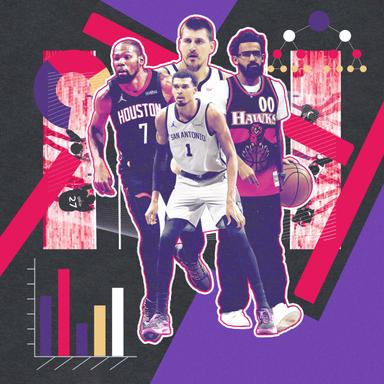Welcome to While You Were Scrolling, a new column wherein I bounce around the league to highlight some of the more creative and intriguing sequences that have caught my eye and you may have missed. These will range from expertly scripted post-time-out plays to split-second reads that occur within the flow of a game to random sequences that won’t fit in a regular column but are still worth some attention.
The NBA is seemingly getting faster, more homogenous, and less structured every year. But it’s also a copycat league. Thanks to innovative teams like the Indiana Pacers and Memphis Grizzlies (before Taylor Jenkins and Noah LaRoche were fired), more clubs are adopting offensive philosophies that ditch convention by emboldening all five players on any given possession. There’s ingenuity everywhere you look—splotches of Technicolor on an endless black-and-white ream of spread pick-and-rolls and transition 3s.
The action pointed out in this piece can’t happen without some combination of timing, motion, elbow grease, and the occasional sleight of hand. There’s a whole bunch of deception in every NBA playbook; sifting through it in real time is not easy, particularly when the set is well-executed by such intentional participants. The devil, however subtle, is in the details. With that said, let’s pop the hood and take a look.
Will Hardy is worth every penny.
If I’m being honest, the Utah Jazz inspired this article. Their whole aesthetic is offbeat in the most enjoyable ways, and it’s straight from Hardy’s all-verb, no-noun playbook of off-ball screens, seemingly random cuts, and side-to-side ball movement that accentuates a bunch of bigs who do a pretty good job of impersonating guards.
This sideline out-of-bounds play against the Celtics was a thing of beauty to everyone except Anfernee Simons, who didn’t realize he needed to switch onto Ace Bailey until the 6-foot-9 rookie was already in a dead sprint back toward the middle of the floor:
The play is as intricate as it is fast. Generally, I just like what running it does for a 19-year-old whose career got off to a slow start. It’s an easy way for Hardy and his coaching staff to convey trust in their green lottery pick.
There are dozens of unpredictable examples like that one. Back screens that lead to lob dunks tossed 40 feet from the hoop. Lauri Markkanen scurrying around the court, wreaking havoc with and without the ball in his hands. Jusuf Nurkic empowered to make reads from the elbow. Here’s a pretty one unleashed against the Lakers that helped welcome LeBron James back to the NBA (and reminded Luka Doncic that defensive effort is not optional against this particular opponent):
Watch the Jazz. Despite their 5-10 record and probable trip to the lottery, they’re distinct and stimulating, and they boast a resourceful head coach who knows how to steal a marginal edge. If you’re not good, be interesting. That’s Utah.
How about them Raptors?
Entering this season, I was pretty high on the Raptors. Part of it was deep faith in a starting five that had enough complementary talent to excel on both ends. If everyone stayed connected on defense, shared the ball, and scrounged up enough tough shotmaking to subdue the presumable spacing issues, things could pop. And so far, so good; the Raptors have the fifth-highest net rating in the league and sit at second place in the East.
Here’s a possession from a recent win in Philadelphia that speaks to why Toronto has been one of this season’s more pleasant surprises. Mainly, they play fast and for each other:
It’s a fantastic example of how the Raptors need to function if they want to stay ahead of defenders who don’t fear their outside shooters. It begins with a stagger pick-and-roll for Immanuel Quickley that busts when Tyrese Maxey gets over Jamal Shead’s screen and forces Quickley back to his left hand. No problem. Quickley flips the ball to Shead and then immediately scampers off a flare screen by Jakob Poeltl. With Andre Drummond in the paint and Maxey caught on the pick, Quickley is suddenly a threat who forces Justin Edwards to stunt off RJ Barrett in the strongside corner. Quickley reacts by hitting Barrett, who drives baseline, draws in Drummond, and then hits Poeltl in the paint. It’s gorgeous team basketball.
Here’s another tremendous example of why predictability is death. Later in the fourth quarter of the same game, Philadelphia blitzed Quickley, so, anticipating it would happen again, Toronto shorted the pick-and-roll:
When the Sixers put two on the ball, Quickley doesn’t force a tough pass to Poeltl. Instead, he swings it over to Scottie Barnes, who has a cleaner sight line to Toronto’s rolling center. And if you’re wondering how Poeltl is so open, just look at the weak side, where Brandon Ingram is coming off Barrett’s wide pindown, occupying Quentin Grimes’s and V.J. Edgecombe’s attention. Nobody stands still. Everyone is animated and has a purpose.
Finally, after missing the playoffs the last three years, everything is coming up Toronto.
The Clippers are sad, but at least they have Tyronn Lue.
As The Ringer’s resident Clippers defender, allow me to concede that times are indeed extremely tough around here. This team looks old, slow, and sloppy. Serious injuries to Bradley Beal and Derrick Jones Jr. helped sap any early-season optimism, and Kawhi Leonard missed three weeks with an ankle sprain.
L.A. has been in a tailspin, losing nine of its past 10 games, hampered by the league’s steepest drop in defensive rating. It’s currently projected to barely make the play-in tournament. And yet, aside from James Harden turning back the clock, there is a sliver of a silver lining: Ty Lue remains an X’s and O’s genius. His ATOs are like a game of Clue that forces defenders to guess until the very end who exactly the play is for. Here’s an example from a game the Clippers actually won:
The idea here is to convince the Dallas Mavericks that the ball is going to a red-hot Bogdan Bogdanovic. As the play unfolds, Bogi appears ready to curl up around a screen set by Jones, who literally directs him with a wave. Ivica Zubac does the same thing just to make sure Bogdanovic’s defender, Max Christie, follows him out of the paint. James Harden responds by calmly throwing a perfect pass over the top, just as Bogi seemingly comes up to get the ball. Pure fluff in its finest form.
Cade Cunningham, master chef.
Every point guard can’t be blessed with a supporting cast chock-full of 3-point shooters who create space and simplify every action. Cunningham included. The more polished he gets as a scorer, the more defenses will shrink the floor and ignore the non-shooters in Detroit’s rotation. All this is to say: It’s encouraging whenever he untangles these knots on the fly:
Kyle Filipowski couldn't care less about Ron Holland II when he’s standing 30 feet from the basket. His goal is to offer help defense at the nail and cut off a potential right-hand drive. Cunningham’s patience wins the battle, though. Stuck in a crowd, he nods his head toward the paint and tells Holland to cut through. It works like a charm, forcing Filipowski back a few steps and giving Cunningham just enough room to cook Ace Bailey for the and-1.
Sometimes the Lakers make it look too easy.
I’m a sucker for perfectly arranged plays that look effortless and unguardable at the same time. This high pick-and-roll between Luka Doncic and Deandre Ayton deserves two thumbs up:
It begins with Austin Reaves screening Myles Turner (pick the picker) and then spacing out to the right wing. When Ayton sets his ball screen, Turner and Kyle Kuzma stay with the ball as he dives into the paint. Now, here’s where things get a little interesting. Doncic, being the genius he is, waits a beat for Ryan Rollins to move off the elbow—he can’t leave Reaves open!—before he starts to drive.
The alignment here is key. To Luka’s right, in the strongside corner, is Bronny James, who’s defended by Giannis Antetokounmpo. In the weakside corner is Jake LaRavia, with AJ Green (a.k.a. someone less intimidating than Antetokounmpo) responsible for both LaRavia and the rolling Ayton. Those two Lakers are where they are for a reason. They aren’t interchangeable. Swap them on the court, and Luka’s options are suddenly limited by Giannis in the middle. But with him in the strongside corner and Green now tasked with guarding two guys at the same time, the Lakers make their alley-oop look easy.
For one play, at least, the Lakers found a way to overcome Milwaukee’s ability to guard four offensive players with five defenders. It’s far from foolproof and not the most complex action, but sometimes the most deliberate details tend to get lost in the sauce. Credit to JJ Redick for getting the best of his former coach.
I also want to quickly shout out this Lakers stack pick-and-roll that caught the Spurs off guard two weeks earlier:
Instead of telegraphing his back screen on Victor Wembanyama, Marcus Smart doesn’t go until the initial pick-and-roll between Luka and Ayton has already happened at the logo. That delay throws off Jeremy Sochan’s and Devin Vassell’s timing by a half second, giving Doncic the space he needs to drill a wide-open 3.
Jimmy Butler is a genius.
For people who can’t see past his combustible hostility, eccentric behavior, and entrepreneurial spirit, please understand that Jimmy Butler is a brilliant basketball player. He not only knows where everyone is supposed to be, but he can then use that information to see the future. It happens all the time. Here’s one example from a recent game against the Suns:
The very first thing Butler does when he grabs the rebound is survey the floor and point Steph Curry to the left corner: the rationale being that he wants to create space for a high pick-and-roll with Quinten Post. Devin Booker isn’t going to stunt off the greatest shooter who ever lived, let alone rotate all the way over to help. He’s stuck. Butler knows this, so he drags Mark Williams away from Post and promptly leverages Curry’s gravity to manufacture an open 3.
Last year I wrote a story about Nikola Jokic’s brain. There’s a stat in there from Crafted NBA that quantifies basketball IQ on a scale from one to 100. The site’s owner told me there are two players who literally measure off the charts. One is Jokic. The other is Butler.
The Nuggets are doing Nuggets things.
I can’t write this piece without including a hat tip to the Nuggets. Their nuanced, organized, propulsive chaos is tried, true, and impossible to deal with. But the play I want to cover here doesn’t exemplify the singularity of Denver’s offense so much as show why it’s still nearly impossible to stop even when it's relatively bland.
Jamal Murray feeds the ball to Nikola Jokic at the left elbow and then looks to come off a screen set by Aaron Gordon. As he does that, Christian Braun relocates to the opposite corner and clears out one side of the floor. This isn’t a predetermined set play. It’s a choose-your-own-adventure.
When the Clippers switch at the top, Gordon suddenly has Cam Christie on him instead of Nicolas Batum, and there’s no help in sight. Jokic recognizes it first—of course he does—and motions for Murray to stop dribbling and pass Gordon the ball. What follows is straightforward, predictable, and a sequence that demonstrates how deeply ingrained Gordon is in the fiber of Denver’s offense:
Isolation play is not what makes the Nuggets great. What does is how they encourage Gordon to go one-on-one for an easy bucket. (A fun wrinkle is that Braun, in the weakside corner, can set a screen on Tim Hardaway Jr.’s man if the Clippers ever wanted to put themselves in rotation.)
Denver is always looking to exploit a weakness, regardless of where it is. When a team’s two best players are willing to stand around and create space for someone else, their combination of selflessness and trust in one another becomes a weapon in and of itself.






